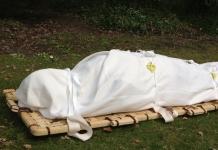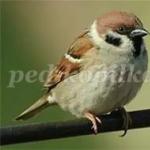It is impossible to imagine a modern garden without climbing plants. They decorate fences, walls of houses and outbuildings, decorate arches, pergolas, and gazebos. A special place in vertical gardening is occupied by the “king of vines” -. With its luxurious display of colors and dense wall of green leaves, no other vine can compare. In this article we will look at the variety - Ville de Lyon.
Let's start with the description of the plant. The most popular and one of the most beautiful is the clematis of the Viticella Ville de Lyon group. The variety was bred in France in 1899 and this old variety still enjoys constant success among gardeners.
It is a shrubby vine up to 3.5 m high. Bright crimson flowers with a paler middle of the sepals bloom from July to August on the shoots of the current year.
Advantages and disadvantages
The advantages of the variety are:
- lush and long flowering (for more than 2 months);
- the longevity of the vine and the ability to increase the flower mass every year;
- ease of care;
- winter hardiness and disease resistance.
Flaws:
- The only drawback is that the middle of the flower burns out in the sun.
The color of the flower becomes less bright, but the decorative effect is not lost.
Reproduction
There are several ways to propagate the ville de lyon species:
 Clematis flower close up
Clematis flower close up - Green cuttings
Ville de Lyon is propagated by cuttings during the budding period, this is the period from the end of May and throughout June. Cuttings are taken from the middle part of the shoot and cut into segments with one internode and two leaves. Below the internode leave 3-4 cm, above 1-2 cm.
The end of the cutting is dipped in a root formation stimulator (Kornevin, Heteroauxin) and planted in cups or greenhouses.
- By layering
The easiest and most reliable method of reproduction. The shoots are placed in the grooves prepared at the ville de lyon bush, 5-7 cm deep. The shoots are pinned to the ground, covered with light nutrient soil and watered. Over the summer, a well-developed shoot with its own root system is formed from each internode. It is better to divide and plant cuttings next spring. For the winter, the area with layering needs to be mulched.
- Dividing the bush
If a young bush (5-6 years old) is divided, then it is dug up, removed from the ground and divided into parts, leaving 2-3 shoots in each.
When dividing old, powerful bushes, they are not removed from the ground, so as not to seriously injure them, but part of the rhizome with shoots is separated and planted.
Planting and care
 Decorative fence decorated with clematis
Decorative fence decorated with clematis Ville de lyon is planted in sunny places, but since their roots suffer from overheating, the lower part of the plant needs to be shaded or the plantings should be positioned so that the plants are in the shade during the midday hours. Flowers do not like drafts and areas with stagnant water; waterlogging of the root system can lead to the death of the plant.
Clematis prefers neutral or slightly alkaline fertile soils with good porosity.
Clematis can be planted with an open or closed root system.
- Planting clematis with an open root system can be done both in spring and autumn.
In the planting hole, a mound is made from the ground, on which the straightened roots of the seedling are placed. The root collar of the seedling should be 10-15 cm below the soil level. The planting hole with the seedling is filled with fertile soil and watered well.
- Flowers with a closed root system can be planted throughout the entire growing season. Plant in prepared holes measuring at least 60*60*60 cm, with a good drainage layer and fertile soil, filled with humus or compost.
When planting, you need to immediately install supports for the plant so that installation at a later date does not damage the growing root system.
When planting several clematis, the distance between them should be at least 1 m.

Further care of seedlings consists of:
- in watering followed by loosening and mulching the soil under the seedlings, in order to avoid drying out the soil and overheating the roots;
- in mandatory plant feeding, starting from the second year of life.
a) in the spring, with the beginning of shoot regrowth, nitrogen fertilizers, mullein infusion or bird droppings are applied.
b) during budding they are fed with complex mineral fertilizers.
c) during flowering, fertilizing is given every two weeks, alternating organic fertilizers with mineral ones.
d) in August-September, ash is added for better ripening of the shoots.
- in pruning shoots. Clematis Ville de Lyon belongs to pruning group 3, i.e. it blooms only on the shoots of the current year. Clematis belonging to this group begin to grow new shoots every spring from the ends of old ones, so they require drastic annual spring pruning. It consists of removing all last year's shoots, leaving only the lower strong pair of buds, from which new powerful shoots will grow.
Growing problems
- Suspension in development in the first year after planting is possible in case of improper care, namely lack of moisture. It is necessary to restore sufficient soil moisture and apply nitrogen-containing fertilizers with microelements.
- when the tops of young shoots dry out, it indicates a lack of moisture in the soil or the presence of aphids on the shoots;
- at the age of 5-6 years, the plant may experience shredding of flowers, which indicates insufficient nutrition and watering;
- Slow growth and growth of shoots indicates insufficient deepening of the seedling when planting; you need to add a fertile layer of soil of 10-15 cm under the clematis.
Preparing for winter
Clematis Ville de Lyon is winter-hardy and with light shelter for the winter it can withstand frosts down to 30-35°C. After the onset of stable frosts, the soil under the clematis bushes is covered with humus or fallen leaves, and shoots removed from the supports are placed on top. They will serve as additional cover for the bush. These shoots will be pruned in the spring.
 House wall decorated with clematis flower
House wall decorated with clematis flower Protection from diseases and pests
Clematis are practically not affected by pests, but it is possible for a plant, especially a young one, to be damaged by a root-knot nematode. Signs of damage are the appearance of swellings (galls) on the roots, which combine to form large conglomerates. Infected plants lag behind in development, leaves and flowers become small, flowering stops, and roots die.
Control measures include removing infected plants, and for preventive purposes, plants that suppress the development of root-knot nematodes should be planted next to clematis bushes, namely: parsley, dill, coriander, Chernobrivtsy, calendula.
Fungal diseases affecting clematis include:
- wilt (withering)– the most dangerous disease leading to the death of the plant. For prevention purposes in spring and autumn (before sheltering for the winter), clematis are watered with lime milk, and during the growing season the soil under the clematis must be watered with a pink solution of manganese or a solution of foundationazole;
- rust– the appearance of red, swollen spots on the leaves. For preventive purposes, it is necessary to spray vegetative plants with 0.5% Bordeaux mixture or the preparations Polykh, Oxykh, Skor, Bayleton;
- powdery mildew– the appearance of a white coating on the leaves, shoots and flowers, followed by their drying out. Control measures include treating diseased plants with Fundazol, Topsin-M or colloidal sulfur.
Once you plant a Ville de Lyon clematis bush in your garden, you can stop. You will want to decorate your garden with arches of clematis and plant this weaving beauty near the gazebos. Plant and have fun!
Clematis is called the “king of climbing plants”: among these plants there are herbaceous subshrubs, shrubs, and vines that grow in regions with a temperate climate, including central Russia. Before planting clematis on the site, you need to find a well-lit area. Most varieties do not require a special soil composition, complex care or a lot of space, since this flower has a small root system. It is frost-resistant and tolerates dry conditions well, especially two types: stinging and Manchurian.
Many clematis look great in vertical gardening; it can be used to decorate gazebos, fences, and arches on your site. It can be grown in open ground and with a closed root system. Winter shelter is required in the same climatic conditions as roses - they tolerate light frosts perfectly. Reproduction is possible by seeds, grafting or cuttings.
Types of clematis
Species are divided into many sections, but it is difficult for amateur gardeners to delve into this classification, therefore for them it is better and easier to use the system of dividing plants along the maternal line.
The following groups of varieties are distinguished.
Climbing grandiflora
- Jacqueman hybrids. These include: Piilu, Rouge Cardinal, Hagley Hybrid,
- Hybrids of purple clematis (Viticella). These varieties are: Ville de Lyon (Ville de Lyon) and Purpurea Plena Elegans (Purpurea Plena Elegans).
- Hybrids of woolly clematis (Lanuginosis).
- Hybrids of spreading clematis (Patens). These varieties are: Nelly Moser, Multi Blue, Miss Bateman, Kaiser.
- Flowery clematis hybrids (Florida). These include the white variety Jackmanii Alba (Jacman Alba), Mrs Cholmondeley (Mrs. Cholmondeley).

Large-flowered bush
These are hybrids of whole-leaved clematis (Integrifolia). This group includes: Aljonushka (Alyonushka), Sisaja Ptitza (Blue Bird), Pamjatj Serdtza (Memory of the Heart).

Small and medium flowered
- Armandii (Armanda),
- Montana (Montana),
- Recta (Recta),
- Texensis (Texensis),
- Alpina (Alpina),
- Nekharetala (Hexapetala),
- Heracleifolia (Heracleifolia).

Trimming Groups
Caring for clematis in open ground includes proper pruning, for which you need to know the group to which a certain variety belongs. This affects not only the shape of the bush, but also its decorative qualities and the way it blooms. The types of these plants are varied in structure and require different pruning options. To make this task easier for gardeners, a classification was created, divided into 3 groups, according to the nature of the life cycle.
- First group: the plant lays buds on last year’s shoots, so it is better not to prune them, if necessary, carry out only sanitary pruning. You can prune after the bush has flowered. Plants of this group are unpretentious, frost-resistant, and require minimal care in the open ground.
- Second group: vines and shrubs of this group can bloom twice during the season, first in May - June, then, more abundantly, in mid-summer. First, flowering occurs on the branches of the previous year, then on the current year. Because of this pattern, plants require double pruning. The first is carried out at the beginning of summer, when the flowering wave ends, the second is carried out in the fall, shortening annual shoots by a third of their length. These are large-flowered hybrids of Lanuginosa and some representatives of Patens and Florida, including the Multi Blue variety. They usually do not need shelter for the winter.
- Third group: blooms in July on the branches of this year; caring for them is considered the easiest. Pruning is done in autumn or spring. The shoots are shortened, leaving 2-3 internodes. If you plan to propagate the bushes, you can use the remaining cuttings for this. The number and size of flowers depends on the number of buds: the more there are, the more pieces, but their size will decrease.

It is possible to trim to a stump, but then there will be fewer branches and the flowers will become larger. What is better, you need to decide for yourself. The third group includes white stinging (White Cloud variety) and bush Manchurian clematis, herbaceous species, hybrids of Jacqueman, Vititsella and some other large-flowered varieties, including Purpurea Plena Elegans, Hagley Hybrid.
Varieties of clematis
Clematis, depending on the size of the flower, can be small-flowered or large-flowered. Reproduction of varietal plants is possible only by vegetative means. Varieties can be early-flowering or late-flowering, some bloom twice a year.

Early flowering large-flowered varieties:
- Piilu (Piilu),
- Miss Bateman (Miss Bateman),
- Nelly Moser (Nelly Moser),
- Purpurea Plena Elegans (Purpurea Plena Elegans),
- Kaiser (Kaiser),
- Multi Blue (Multi Blue).
Late-flowering large-flowered varieties:
- Hagley Hybrid (Hagley Hybrid),
- Ville de Lyon (Ville de Lyon),
- Ernest Markham (Ernest Markham).
Early flowering small-flowered clematis include:
- Frances Rivis (Frances Reeves),
- Constance (Constance),
- Manchurian,
- Burning (Variety White Cloud).
Late-blooming small-flowered clematis:
- Bryzgi Morja (Sea Splashes),
- Jouiniana (Juiniana).
Planting clematis
The most popular in the middle zone are small-flowered species - bush Manchurian and stinging, which tolerate cold much better than others, they do not need to be covered, and bloom on the branches of this year. Growing and caring for these clematis in the country does not require special skills. Of the large-flowered varieties, Multi Blue, Purpurea Plena Elegans, and Piilu are often grown in open ground. Many of them bloom twice a year. These plants are light-loving and prefer an open place, but can tolerate slight shade.

Planting and growing clematis can be done in almost any soil, but they like a neutral or slightly acidic reaction. Acidic ones need to be limed. Waterlogged and clayey soils are not suitable at all; this has a bad effect on the root system. It is better to use a nutritious loamy substrate. The main parameter is moisture capacity. This flower prefers moderate humidity, without stagnant water. When the dacha has clay soil, sand and peat are added to it. In dry sandy soils it is necessary to add humus, peat or rotted leaves.
You can grow these vines with a closed root system, but you should add drainage to the bottom of the pot or container. Before planting clematis, you need to dig a hole with a diameter and depth of 60 cm. If you plan to plant clematis in soils where there are few nutrients, it is better to make it wider to add organic fertilizers. When the soil is dense and clayey, drainage made of crushed stone or coarse sand should be placed at the bottom to prevent rotting of the root system.

How to plant clematis correctly? Before planting, the shoots are pruned to the second pair of buds. If the seedling was in a container or other place, the planting should be 10 cm deeper than before. Grafted plants are also buried so that the grafting site is underground. A small depression is left around the seedling, where soil is then added when the clematis grows. The soil around is compacted a little and watered. The shoots are tied up, giving them direction, otherwise they will intertwine chaotically, lose their decorative effect and will be more difficult to care for.
Planting and caring for young plants
After planting, you need to water abundantly, once every 7 days. The soil is loosened 3 days after watering. When the weather at the dacha becomes hot, watering is increased to 3 times every 7 days. Caring for clematis includes mandatory mulching after watering and loosening, since many of them suffer from overheating of the soil. In the south this is done with sawdust, in the north - with peat or humus. Shading the bases of the shoots is useful.
Closer to winter, the area in the country where clematis grows needs to be well dug up with organic fertilizers. They are laid out around the site when digging is planned. You can increase the rate of mineral fertilizers if you do not plan to apply organic fertilizers. To do this, 15 grams of complete fertilizer are diluted in a bucket of water. In the spring, when next year's shoots grow, the plants are fed with nitrogen fertilizers.
Advice! Clematis love spring watering with lime milk - 50 grams of chalk or slaked lime in a bucket of water.
You need to feed at least 3 times per season, but it is important not to overdo it with feeding, as the plants may die from its excess. The first time feeding is done when buds form, the second time after spring flowering, the third time after summer flowering and pruning (Multi Blue variety and the like). Small-flowered Manchurian and burning clematis can be fed less frequently, up to 3 times per season.

Autumn plant care consists of sheltering for the winter. To do this, after the first frosts and pruning, they are covered with 1-2 buckets of sawdust, earth and snow up to 25 cm thick. This allows them to withstand frosts down to -35 °C. If you need to preserve this year's shoots, for example, those of the Multi Blue variety, they are carefully removed from the supports, cut to 1.5 m, pressed to the ground, covered with boards and covered with a mixture of sawdust and earth. The cover is removed when the branches begin to grow.
Clematis propagation
Reproduction of species clematis is possible by seeds and vegetatively, while varietal clematis can be propagated only vegetatively. Manchurian and stinging species, the cultivation and care of which are considered the simplest, can be propagated by seeds using the seedling method. Such plants bloom in the second or third year if the care is correct. To preserve varietal characteristics, cuttings or dividing the bush are usually used.
Large-flowered varieties propagate well from cuttings in late spring. During this period, the plants are in a state of budding - this is an indicator of the readiness of the shoots. It is better to harvest them in the morning, when there is a greater supply of water in the branches. They are cut with sharp pruning shears, cutting them into cuttings with one internode. Then bunches of 25 pieces are tied together and placed in a solution of a root formation enhancer - green ones for 18 hours, and lignified ones for a day.

After this, the cuttings are rinsed in running water, planted in boxes with a peat-sand mixture (2 to 1) obliquely, with recess, watered and covered with sawdust. You can put the boxes in a greenhouse in a shaded place. Care consists of watering the cuttings 3 times a week for the first month, and then every day. Shoots take root after 6 weeks. Propagation by seeds is a more complex process, since in central Russia they rarely set, and with this method varietal characteristics are not transmitted.
Conclusion: clematis are beautiful plants, many of the varieties are frost-resistant and do not require special shelter for the winter. There are many types, forms and varieties, which are conventionally divided into groups according to the degree of pruning and maternal lineage. These shrubs can bloom on branches from last year or this year, and some species can bloom on both.
Reproduction is possible by dividing the bush, seeds, cuttings, grafting. Vegetative methods are used more often, since in this case all the decorative qualities of the mother plant are preserved. One of the best options is cuttings. Care consists of watering, fertilizing, proper pruning and winter shelter, if necessary.
In Russia, the plant began to be grown not so long ago. Anyone wants to decorate the local area of their cottage or home. But often you want the buildings themselves to look lively and attractive. This is exactly what climbing plants are used for. Ville de Lyon is ideal for this purpose.
This plant variety was created in France about 150 years ago. It is widely used to decorate gardens in Western Europe. In our latitudes it can be found in almost every home.
Reproduction
There are 3 ways to propagate the variety. Reproduction occurs:
When dividing a bush, a young plant is dug up and divided into several parts, and each of them must have at least 2 shoots.
When dividing an old plant, it is not removed from the soil, but only part of the root system with shoots is separated and replanted.
Diseases and pests

This plant often suffers from wilting, as well as rust and powdery mildew. As a preventative measure, the vine should be treated with specialized means in the spring.
Charming and elegant clematis are still considered amazing exotics in Russian gardens today. The most popular and famous varieties of these flowers in our country are clematis “Purpurea Plena Elegans”, purple clematis, Tangut clematis and some other varieties, the reviews of flower growers are very enthusiastic.
Decorative botanical clematis is very diverse. Growing this plant from seeds is a rather complicated process. Clematis seeds are difficult to germinate, so most gardeners choose other methods of propagating the plant. Depending on what group of clematis is grown, plant care and pruning method may be different.
The variety is characterized by the presence of round and bright flowers. In addition, a distinctive feature is relatively early, abundant flowering, disease resistance and unpretentiousness to the soil. The vines of the plant reach three meters in height, and the diameter of the flowers is about ten centimeters. Yellow stamens look impressive on red flowers. The flowering period is quite long and can exceed two months.
.jpg)
Very popular among flower growers. This large-flowered ornamental plant is a vine with a height of about two meters. Clematis has original purple flowers with a very bright red stripe located in the middle part of the sepals. The diameter of the flowers does not exceed nine centimeters, the stamen filaments are white, the anthers are dark red.
The main flowering period occurs in July and lasts until September. The plant belongs to the third pruning group. distributes flowers along almost the entire length of the vine. The plant at the flowering stage is showered with flowers from bottom to top.

Plants belonging to the variety "Purpurea Plena Elegans", in summer they are covered with a mass of double and very picturesque flowers. Compositions made from them are perfect for a retro-style setting. This variety was developed in France in 1899 and belongs to the Viticella group. The length of the vine can vary from two and a half to three and a half meters.
Terry bright flowers have a red-purple color, and their diameter is about nine centimeters. Stamens and pistils are completely absent on the plant. The flowering of clematis of this variety is characterized by exceptional abundance and duration. As a rule, the main flowering stage begins in July and continues until September on the shoots of the current year. The plant belongs to the third pruning group and is very resistant to unfavorable growing conditions.

Clematis "Rouge Cardinal"
Popular clematis "Rouge Cardinal", or "Red Cardinal" belongs to the Jacqueman group and was bred in France before 1968. The deciduous beautiful vine is attached to the support by means of tendril leaves, and the length of the shoots does not exceed two and a half meters. The main color of the sepals is red-purple.
The flowers themselves are velvety and have a middle stripe that is slightly lighter than the main background. The presence of pale purple anthers is characteristic.
Abundant flowering is observed from July to the last days of September. The plant belongs to the third group of clematis for pruning. “Red Cardinal” was awarded several times at exhibitions with medals and certificates.
Yellow clematis called "Radar of Love" is an unpretentious and beautifully branching plant. The very popular Tangut clematis is grown in seedlings. The plant is a perennial flowering vine. It can reach about three meters in height.
Plant flowers Clematis tangutica solitary and drooping, their color is bright yellow. As a rule, the diameter of the flowers does not exceed four centimeters, and their shape resembles small decorative lanterns. The beautiful plant is characterized by a high degree of decorativeness and remains attractive until late autumn, which is due to the presence of silvery fruits, which are very often used in design and arrangement and look very impressive.

Сlematis tangutica is used for vertical gardening, and also, if necessary, to decorate a terrace, building facade, fence, gazebo, or when creating a vertical local lawn decoration using a figured support. In addition, the plant is used as a ground cover in the garden.
Caring for clematis of this variety is standard and not difficult. Proper pruning and shaping of the bush allows you to grow “Radar of Love” at home.
Clematis Viticella
The widespread clematis Viticella is the most famous and beautiful. The category of such plants includes varieties in which one of the parent plants possesses most of the genes from Clematis viticella. But the hybrids obtained from Clematis integrifolia, cannot be included in this group.

Clematis of this species include deciduous types as well as climbing shrubs. All flowers are formed during summer or early autumn exclusively on the shoots of the current year. Flowers can be single, semi-double or double. Standard flower diameters can vary from two to fifteen centimeters. Clematis viticella blooms on the current year's shoots.
The total number of sepals can vary from four to six. The main color can be one color, white, or have various shades of pink or bright red. Red-violet colors are quite common, as well as purple coloring and violet, blue or blue shades. The leaves are characterized by pinnateness; trifoliate types of leaves are less common. Lack of quality pruning can provoke strong plant growth and flowering at a significant height.
The most popular varieties from this group: "Etoile Violette", "Alba Luxurians", and "Carmensita", "Polish Spirit" and others, including purple clematis.

Clematis violet
Violet clematis, or Viticella, very popular among gardeners, grows under natural conditions in the Caucasus, as well as in Southern Europe and Asia. Clematis violet, fashionable today, is a shrubby vine with a height of up to two meters and has double-pinnate leaves. The presence of a thick, cord-like root system allows the plant to be used as a very convenient rootstock for large-flowered clematis.
Abundant flowering of the plant is observed on the shoots of the current year. These shoots should be pruned in the fall, which guarantees abundant flowering in the fourth year of the plant’s life.
Flowering is quite long. As a rule, this period lasts from June to the end of September and ends with the setting of a significant number of seeds that are large enough and convenient for sowing. The ripening of seed material is observed in September.
Caring for clematis in the garden (video)
When choosing plants for your garden plot, you should pay attention to clematis. These beautiful and not too demanding flowers will be an excellent decoration for the local area.





















